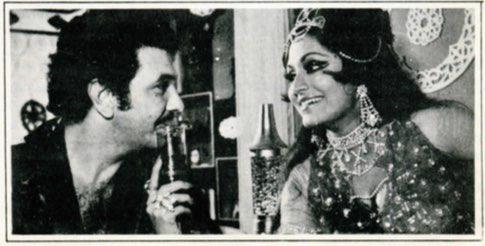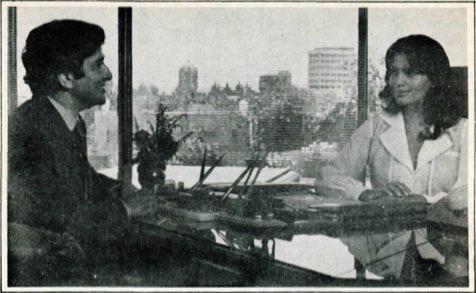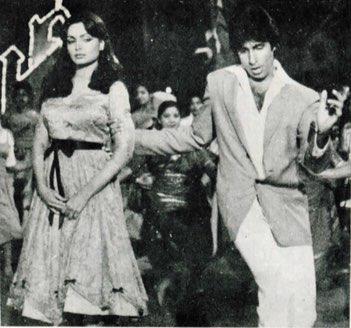Aruna Vasudev
This has been adapted from an article by the author that appeared originally in Indian Cinema Superbazaar, (New Delhi, Vikas, 1983)
It is no coincidence that the first Indian film was a 'mythological'. The moral education of all but the thinnest layer of affluent, westward-looking Indians is derived from the epics. These stories, despite liberal doses of miracle and fantasy are no fairy-tales easily told and as easily forgotten. Nor are they irrelevant to real life, a part of the literary and artistic heritage of the past as Greek mythology is for western civilisation. On the contrary, they have a living reality and a dominant influence on the conduct of daily life till today.
Unfortunately, for the women of India.
The example of Sita, the perfect woman, the perfect wife, acquiescing unquestioningly to her husband's rejection of her in what is nothing more than an abject surrender to the prejudice of male-dominated society, has been held up as the ideal for all women to follow. Taken in conjunction with the rules of Manu the 'Law-Giver', the average woman in India has had no opportunity to become anything more than daughter, wife, mother. 'In childhood a female must be subject to her father, in youth to her husband, when her lord is dead, to her sons; a woman must never be independent', wrote the 'great' Manu, and with these few lines, condemned women to a life of eternal subjection for two thousand years. Tradition required it, today the cinema enthusiastically upholds it. In film after film one sees these values reiterated, underlined, reinforced.
To the weight of this tradition is added a Victorian hypocrisy which still dominates the thinking of westernised Indians — a middle-class morality which makes a sharp distinction between woman as wife and mother, and woman as mistress and lover. Love is by no means forbidden. A woman may love a man — Radha loved Krishna — but it has to be a sublimated, pure and eternal love. The prostitute too, must subscribe to this convention. When she falls in love, she must give up her profession to devote herself to the object of her devotion — more frequently, to the memory of that unattainable love.

Subscribing to the predominantly orthodox views of the large majority of their audience rather than acknowledging the reality of women's growing influence and contribution to society, film makers generally prefer preconceptions of the status of women which perpetuate male domination in society. As such, these portrayals reflect not so much society as it is evolving as how they would wish it to remain.
Within the Family: Wife and Mother
The pinnacle of ambition for a woman is marriage, of achievement, the birth of a son. Within marriage, her role is clearly delineated. If for whatever reason, she deviates from it, it is seen as a betrayal of her biological and functional role and she must pay a price in humiliation and defeat. In a film made in the late Seventies, Thodisi Bewafaii (A Little Indiscretion) the talented actress Shabana Azmi is the personification of a 'modern' young woman. The spoilt daughter of an indulgent father, she marries the man of her choice. When he loses his money, instead of putting her education to constructive use by working (as is happening more and more in real life), she simply picks up her son and goes back to her father. When he in turn loses his job, she trails aimlessly around the house, ending up a drudge in her brother's home. The wheel comes full circle: her brother's wife resents her as much as she resented her own sisters-in-law. Eventually, crushed and defeated, she is pathetically eager to return to her husband. This pattern is endlessly repeated in the majority of 'social' films, where the modern, educated woman is seen as a threat to the status quo which has to be maintained.
It is one of the dichotomies of the Indian film — as of Indian life — that the woman is, on the one hand, venerated as a mother and, on the other, victimised as a wife. This happens also in a film that is considered one of the harbingers of the new cinema — Basu Chatterjee's Sara Akash (The Clear Sky). The young wife in it is educated, but her ability to read is treated with contempt (arising from envy?) by the other women in the joint family. Her education is shown as serving no useful purpose; a book — a novel — merely provides her with an escape from the taunts of the mother- in-law, and the sulky silence of the reluctant young husband; it is only his unhappy sister who shows any sympathy for her. Abandoned by her husband for another woman, the sister lives precariously in her father's house. She is forced to go back to the husband when he comes to claim her, having been himself rejected by the other woman. Her mother pleads for her, but without any real hope or conviction, acknowledging that the father is doing the socially accepted thing in sending his daughter back into what everyone knows will be a life of misery.
Talking to Basu Chatterjee about the film, one realised that he was not at all aware of in any way condoning the values implied in the film. Unwittingly, perhaps as a result of his own conditioning, the film maker subconsciously subscribes to them.
A film which is considered a landmark in the Indian cinema is Shantaram's Duniya na Mane (The Unexpected), 1937. An orphaned young woman is duped by her money-grabbing uncle into marriage with an old man. Once married, she refuses to fulfil any wifely duties. Her spirited revolt brings the husband round to recognise the iniquity of his action, and the injustice to women imposed by society. He kills himself to leave her free. Although this film has been hailed as the first blow for women's emancipation, it provides only a limited answer because the fate of a widow then, and to a large extent even today, is almost worse than servitude in marriage.

The mother-figure has a prominent place in the cast of characters of most films, none of which ever treat of a relationship between mother and daughter. Even with sons, it is not so much a relationship that is explored or portrayed as the deification of the mother. Self-sacrificing, martyred and victimised by the husband (or by fate) she is shown as indestructible when it comes to protecting her sons. The strong mother-son tie underlies most films and frequently manifests itself in the ill-treatment of the young daughter-in-law — in real life, as in the cinema. The implication is that a woman's only hope of salvation lies in becoming the mother of sons.
Beyond the Family: The Courtesan
Obviously, in the circumstances, no real relationship can develop with a wife who is a potential mother/goddess and therefore must be pure and sexless. With whom, then, can a man have a satisfying relationship, physical and emotional? The courtesan has always been a significant figure in classical Indian literature and, until the Seventies, a staple of the Indian film. Since she is forever excluded from domesticity, she can answer his physical needs and cater to his fantasies (unlike the wife who must be used only for procreation). Of course, he may not fall in love with her, but, inevitably, her heart is lost to him. She provides solace, a haven, and when he recovers sufficiently from his sorrows, he goes his way, leaving her to pine the rest of her life away having lost all taste for her profession. This archetypal prostitute was created in the Thirties in Devdas. Based on a story by the well-known Bengali writer, Sarat Chandra Chatterjee, it was a phenomenal success and virtually one whole generation is said to have wept over it.
In the Sixties, Chetna (The Awakening) broke away from the pattern and made a big impact. It showed a young man falling in love with a girl he discovers to be a prostitute, and marrying her. However, the film stopped short of allowing the marriage to be consummated by contriving an ending in which the heroine kills herself. The premise is daring, the resolution once again conformist. Suicide, or a conveniently accidental death, has always been the solution for uncomfortable situations of all kinds, particularly for women.
Women at Work
Despite the transformation that has taken place in society in the last two decades, and the quite remarkable way in which women have emerged from the doubtful shelter of their homes into a wide variety of jobs at all levels, most films show even educated women with no occupation. When they do work, it is as typists, secretaries or school teachers, very occasionally as lawyers or doctors. The working woman is invariably a young girl doing a job while waiting to get married. This 'modern' miss is almost always shown as the temptress, as man's evil genius. She dresses provocatively in western clothes, smokes, and laces her vocabulary with English words.
In contrast, and in conflict with the working woman, is the traditional, barely literate, sari-clad damsel, a model of conservative virtue who always wins out. The 'modern' girl is either defeated or made to reform, having been brought to see the undesirability of her ways. Everything is idealised, romanticised, sentimentalised. Refuge and release are found in a song, or in prayer. Confronted with situations she cannot handle — and there are many — this woman rushes off to the prayer-room of the house to pour out her grief to her God. Women are seldom shown capable of rational, logical thought or action.

The result of this denigrating depiction of education and a career for women is most unfortunate. In the Fifties, educationists and social workers petitioned the government to do something to counter the effect of films that showed educated women in a negative light. According to them, all efforts to introduce education for girls were being nullified by the negative image of the educated woman as projected by the popular cinema.
The Sex Object
In the Seventies, self-assured, confident women were starting to break out of the economic dependence that had for so long held them in thrall. More and more of them were working, many earning more than men. In a society in transition, the rigidity of past norms could not be maintained. A few films did raise the issue. Insaaf ka Tarazu (The Scales of Justice), a very successful film of the late Seventies, is supposedly a cry against rape. It stars the voluptuous star Zeenat Aman, as a beautiful, successful model. She neither smokes nor drinks, and is not promiscuous, but she is independent, dresses and works as she pleases, lives alone with a younger sister and has no family to lend her 'respectability'. This is totally unacceptable.
Even more significant than the rape in the film is the implicit endorsement of double standards by an inherently hypocritical society. In an early scene where she is shown getting ready to meet her fiance's parents, she discards her revealing dresses for a sari, and modestly covers her head. The parents are delighted. 'We never thought a model could be a good girl,' they say approvingly. Later, after the rape, when she goes to court and loses the case, they reappear and condemn her immodesty for thus exposing her 'shame' to the world. She is made to conform to this notion of 'shame' when she refuses the fiance who is still willing to marry her. 'This body is soiled', she says, and goes away. The court scene is equally revealing. The prosecutor (male) is shown as logical and legalistic while the victim's woman lawyer argues emotionally. Much later, when she kills her violator after he has raped her sister, she is back in the same court, a self-confessed murderer. This time, however, without a lawyer. She makes an emotion-charged speech in her own defence, and is allowed to walk out vindicated. The same parents emerge from the wings and she falls at their feet. 'Beti' (daughter), they murmur endearingly, as they embrace her. So much for immodesty, rape, murder and the law.
Women are seldom shown as understanding or supportive of each other. They are, in fact, the preservers of tradition and each others' worst persecutors, while male camaraderie has always been strong and is emphasised in most films.
Parallel Trends
The approach of the new film makers however, is almost directly opposed to the commercial film. In a variety of languages, in Marathi, Kannada, Bengali, Malayalam, thought-provoking new directors are bringing their own contemporary attitudes to bear on the kind of films they are making. In style and particularly in content, the difference is sharp. Kumar Shahani's Maya Darpan (The Mirror of Illusion) is a film of extraordinary sensibility where it is absurd to separate content from form. The central character is a woman and she is the subject of the film, not in a direct narrative structure but enveloping the audience through a quality of sensuousness rare in Indian cinema. Girish Kasaravalli in Ghatashraddha (The Ritual) exposes the terrible tyranny practised against widows in an orthodox milieu. Adoor Gopalakrishnan's latest film Elippathayam (The Rattrap) is concerned as much with the woman's plight as her brother's inability to cope with life. In Bengal, Satyajit Ray's films have always explored with fine perception, the tensions of women — the inner emotional world in Charulata (Charulata), the more obvious outward conflicts in Mahanagar (The Big City). Mrinal Sen's Ek Din Pratidin (And Quiet Rolls the Day) is remarkable as a film and for the way he exposes the peculiar, unresolved attitudes towards the working, earning daughter of the family.
All these years, the cinema has been the near-exclusive preserve of male directors and writers. Recently, two women have hit the headlines, and a third is not far behind. Sai Paranjpye in Bombay with Sparsh (The Understanding) and Chashme Buddoor (Touch Wood) in Hindi, Aparna Sen with her English-language film 36, Chowringhee Lane in Calcutta, and Prema Karanth in Bangalore

with Phaniyamtna (Phaniyamma) in Kannada. Entirely different in their approach, theme and subjects, Sai and Aparna are both their own scriptwriters. Sai Paranjpye's Sparsh shows the gradual development of a woman from a grieving young widow into a more positive, self-aware individual. 36, Chowringhee Lane though a study in loneliness, shows the inherent strength of the central woman character. Both these films have an urban contemporary background, while Prema Karanth's Phaniyamma goes back fifty years or so to a rural setting. Phaniyamma, married as a child, a widow before she reaches her teens, has to have her head shaved and wear only plain white saris for the rest of her life, from the day she reaches puberty. This lonely young girl's growing up, growing old and dying are portrayed with fine delicacy and beneath it, with seething anger. All the minor women characters also leave strong impressions, and through the generation of women that Phaniyamma loves and tends, the evolution of a society is laid bare. Towards the end, when a 16-year-old girl is widowed she scorns the conventions that still demand, albeit weakly, that she have her head shaved. 'Cut her hair' she shouts at the old barber, thrusting her mother-in-law forward, and goes off herself to bed — and pregnancy — with her husband's younger brother. It is Phaniyamma who says gently to the appalled upholders of tradition that times have changed, and that they cannot any longer continue the dehumanisation of women, so long sanctified by religion and tradition.

